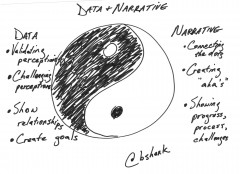In communications, two of our biggest jobs are to 1) translate data and PR metrics into narratives; and 2) narratives into PR metrics.
Every month, my communications team and I get together to fill in our monthly PR metrics dashboard.
It’s not a glamorous process, but it does give us a chance to identify our successes and challenges over time.
And it got me thinking about the two-way relationship between PR metrics data and narrative. They are the yin and yang that comprise the ongoing dialogue we have with our target audiences.
From Data to Narrative
The journey from data to narrative is when communications pros dig deep into research, survey results, analytics, and usage and conversion data to create the strategies and narratives that change minds and influence behaviors.
Often, it’s not about telling the story of all the data, but about finding that single golden nugget that helps crystallizes and position the story you’re trying to tell. Or the golden thread that connects the dots in a way that has never been done before.
So, for instance, recently some of our PR metrics showed that research in our peer-reviewed journal looks like it could get traction among healthcare audiences.
As a result, we had our physician blogger expand on the research by providing his own commentary on our blog. Once the blog post went live, major healthcare outlets found it and picked up both the research and the content from our blog.
Finding those nuggets is a team effort, and they can’t be done without on-going PR measurement, analytics, and resulting analysis.
This is an important part of the job. It’s the currency we bring to the outside world—compelling stories that make our target audiences think just a smidgen differently.
From Narrative to PR Metrics
The second part is the currency we bring to our inside world: Turning the narrative of our work into PR metrics. It’s the only way we can tell our bosses and peers about the work we’ve done in a compelling way.
The goal of this conversion is to be able to analyze and improve our efforts and show stakeholders what we do is valuable.
Our job is to translate the successes and challenges of our work into values they already accept and understand, as well as help them understand why we are measuring what we are and what it means for their long-term strategy and goals.
What to measure? That’s up to you.
Actually, that’s not entirely true, it’s also up to your boss or client. And it must be based around your organization’s goals.
- Measure web visits.
- Measure total circulation.
- Measure total followers and engagement.
Each PR measurement strategy will be unique and developed based on what make sense to you, your boss, and your organization’s goals.
Think of the individual metrics which are part of your PR measurement strategy like measuring blood pressure and heart rate for a hospitalized patient.
It doesn’t tell the whole story of the patient’s health, but it’s a decent proxy for understanding general well-being. And, when brought together with other metrics, help create your treatment plan (or, in our case, strategy.)
Output vs. Outcome; Internal vs. External
In our department, we update a monthly dashboard that includes both PR metrics and narrative for internal audiences (you can see our template here).
It includes data such as number of media mentions, media inquiries, website visits, a social media engagement index, and the number of times people post to our members-only online community (a very important PR metric because we’re a membership society).
There also is an important internal PR measurement: The number of media contacts we proactively reach out to in a given month.
This is an “output” metric versus an “outcome” metric. And, while reaching out to media contacts doesn’t guarantee media coverage, we’ve found over time, it’s strongly correlated to the outcome metrics of media mentions and even media inquiries.
Therefore this is something we include in our internal dashboard, but wouldn’t necessarily include for an external audience.
Both sides of the coin are important.
Monitoring and translating PR metrics benchmarks and goals is a responsibility for both in-house communications departments and agencies alike. Understanding what the client values and measures is the very keystone of trust for relationship; it enables both sides to identify successes to replicate and challenges to address.
After all, a major success for a blog post (narrative) should result in increased click-throughs to your website (data,) and to product purchases (the best data.)
Or a live Twitter-chat that was a bust (narrative) might spur on constructive conversations about reach (data,) ads (data,) and engagement (data, presumably).
All of those data points add up to valuable dots for the communications staff to connect for our internal audiences, and then use to improve strategy and campaign tactics externally.
After all, connecting the dots what we do best.
Image created by the author
